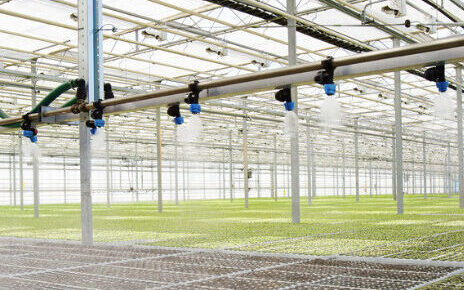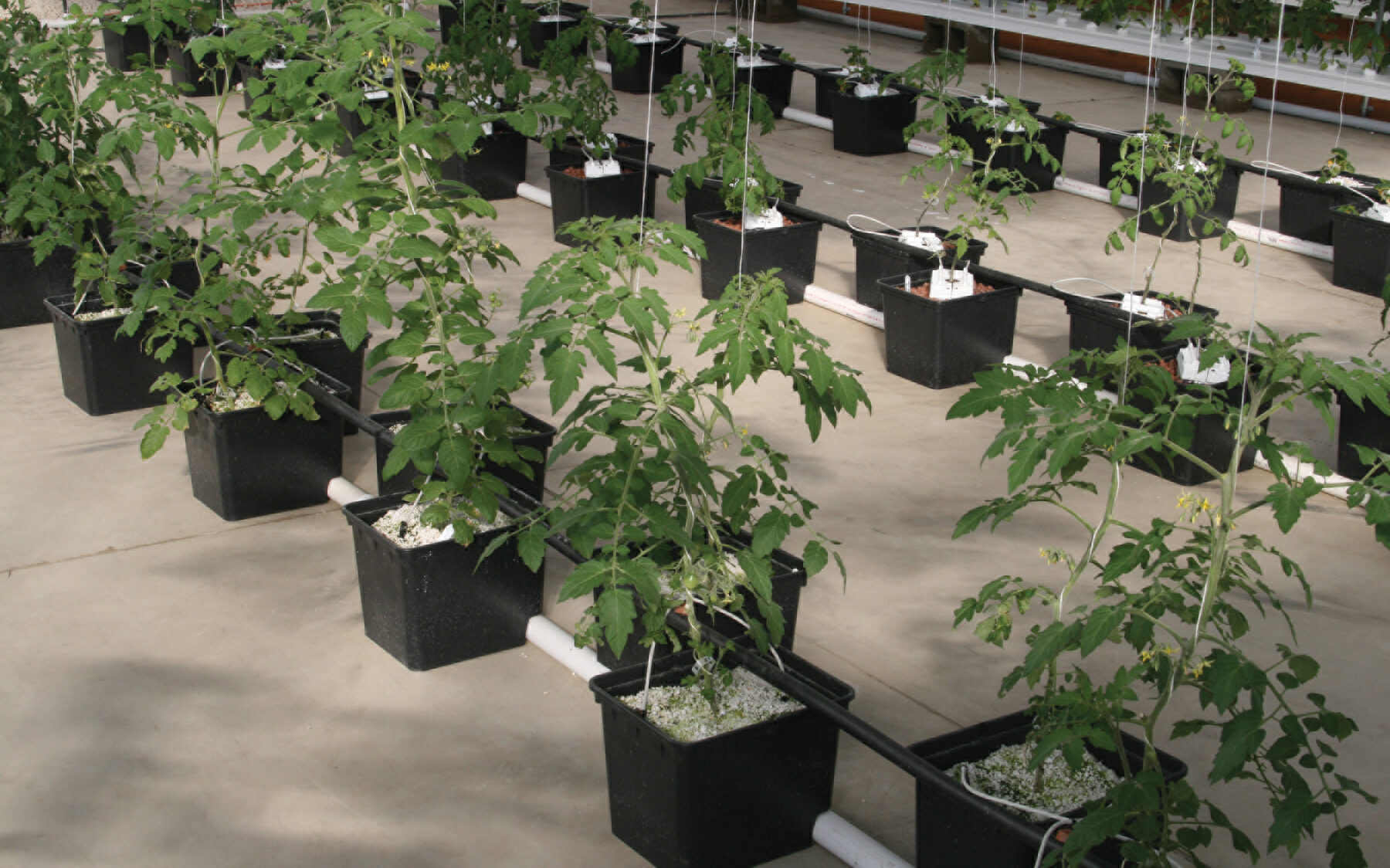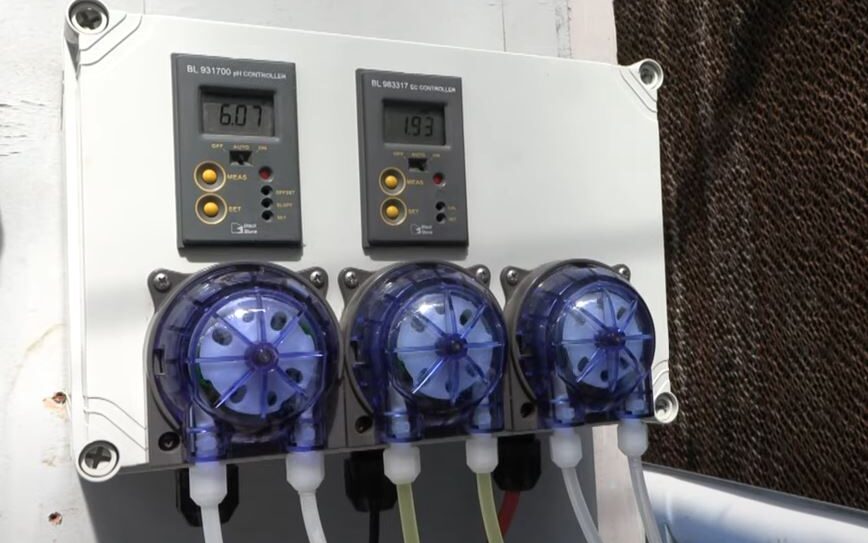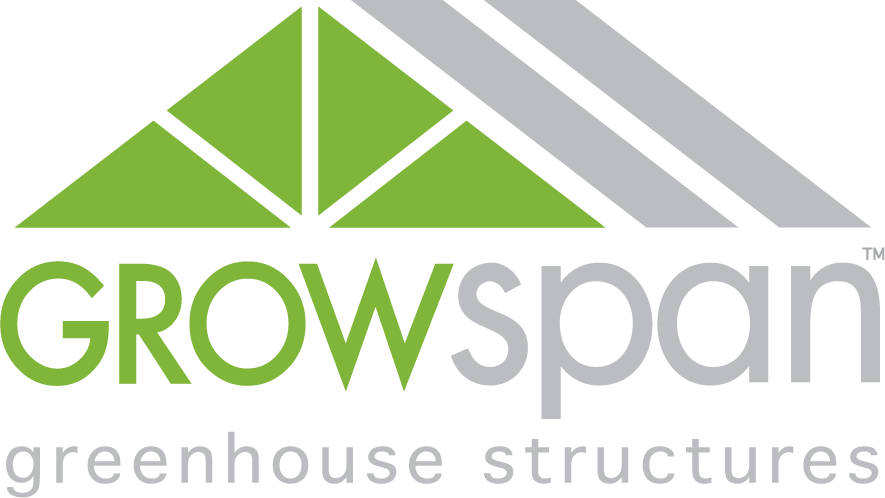Greenhouse Irrigation and Fertigation Offer Boosts to Efficiency and Profitability
For many growers, boosting efficiency in the greenhouse has become a critical focus. While improving the effectiveness of all greenhouse functions should be the end goal, a great place to start is with one of the most essential tasks for any grower. With the increasing danger of longer-lasting droughts, efficiently watering crops has become a serious concern throughout the horticulture industry.
Inefficient watering leads to increased waste, poor nutrient uptake, stunted plant growth and, as a result, lower overall yield. For these reasons, if they haven’t already, growers should consider outfitting their greenhouse with an irrigation system. Installing an automated irrigation system into any grow can provide improvements in water and nutrient usage, reducing waste and lowering costs, while simultaneously enhancing crop development.
Read more below to understand how the various irrigation systems function and how greenhouse irrigation can help growers improve watering efficiency. Plus, this article will cover how growers can improve nearly every aspect of their crops by implementing greenhouse fertigation systems.
Choosing a Greenhouse Irrigation System – Overhead Versus Drip Irrigation
There are many different systems available for growers who are implementing irrigation into their operation. It’s important for growers to understand the different options available to them before choosing, because oftentimes these systems offer advantages specific to the needs of the operation. There are two methods that are the most popular among growers.
One common method for greenhouse irrigation among professional growers are overhead irrigation systems. These systems can be designed to gently mist or spray water across a large distance, increasing watering consistency.
Overhead irrigation is particularly beneficial for large operations growing crops that are small and densely planted, because the far-reaching range of these systems allows growers to water the entire greenhouse in a short period of time. For commercial operations, this can save growers time and labor expenses.
And while these greenhouse watering systems can cover large areas of the growing space quickly, they tend to waste water, which can find its way into undesirable locations, increasing runoff. Still, overhead irrigation systems are a better option for large-scale greenhouse irrigation than watering by hand.

A more efficient, less wasteful way of watering crops is via drip irrigation. Drip irrigation typically consists of small plastic tubing that runs through crop bedding or pots, usually arranged in rows.
The tubing is connected to a water source that pumps at a low-pressure to ensure a slow and steady application. Drip stakes or emitters that release small amounts of water into the substrate are installed into the tubing, providing even water application to crops along the length of the system.
Drip irrigation has the benefit of providing water directly to the root zone. By supplying water slowly to the root zone, these systems provide crops with the ideal amount of water where they need it most.
Plus, they prevent overwatering issues, like drowned roots. Unlike overhead watering, drip irrigation prevents water from coming in contact with leaves and other plant surfaces, reducing the risk of foliar disease.
Drip irrigation is also the most sustainable choice for growers. Not only does drip irrigation tend to have a low initial investment, but these systems provide growers with much greater water efficiency.
The low-pressure water application places drip irrigation among the most conservative greenhouse irrigation techniques available, helping to eliminate water waste by reducing runoff and leeching. In general, drip irrigation can use as much as 70 percent less water than traditional irrigation systems.
One of the major benefits of drip irrigation is its ability to be easily automated. As growers continue to seek more efficient growing equipment and practices, an automated drip irrigation system can be one of the best additions to any grow.

By using timers and sensors that can detect the moisture level of the soil, growers can optimize their water application and avoid under or overwatering. Automated irrigation systems can react to the growing environment, reducing the need to manually monitor crop conditions, improving efficiency and reducing labor costs.
The precision control provided by automated drip irrigation systems also offers growers the opportunity to improve their nutrient application, as these systems can be adapted to balance pH and supply nutrients, a process known as fertigation.
Sign Up Now To Learn More
How Greenhouse Fertigation Systems Improve Crops and Profitability – Lower Costs, Better Growth, Greater Yields
Fertigation is the practice of adding water-soluble nutrients into an irrigation system, supplying crops with both essential components of proper growth via one, efficient method. When automated, these systems enhance nutrient delivery to produce a superior crop, while simultaneously reducing fertilizer waste and lowering costs.
Using fertigation in greenhouse production can yield a wealth of benefits for any crop. While traditional fertilizer spreaders are imprecise, a drip fertigation system can deliver the solution directly to the roots, so that plants are always receiving essential nutrients where they need them most.
Growers also appreciate the improved control over how much fertilizer is being supplied to crops. Nutrient levels can be measured inside a mixing tank based on a grower’s exact needs, and then distributed into their irrigation lines in exact quantities using a dosing system. This precision management over the injected fertilizer contributes to hardier plants, meaning crops are less prone to pests, diseases, nutrient burn and other concerns.

With the more precise application of water and fertilizer, growers can save time and money. Drip irrigation provides a dramatic reduction in water waste, and when combined with fertigation, the savings translates to nutrients as well. Growers can optimize their crops’ development by automating nutrient ratios at the various stages of growth, reducing fertilizer usage and leading to a greater yield of higher-quality crops.
By implementing an automated greenhouse fertigation system, growers can also lower the risk of potentially dangerous human error. Automated greenhouse fertigation systems allow growers to define the ideal parameters for nutrient application and pH balance.
Proper pH balance and nutrient supply leads to better plant growth and a superior crop. These systems then utilize electrical conductivity (EC) and pH sensors that analyze the water, and in response, they make the necessary changes to nutrient and acid content.
EC sensors don’t actually measure nutrient levels in the water, instead measuring the electrical conductivity as water flows through the system. As fertilizer dissolves and absorbs into the water supply, the more electricity the solution conducts. When the EC sensor measures this conductivity and determines it is out of line with desired levels, it automatically doses the nutrient solution, ensuring crops are always receiving the right amount of nutrients.
Similarly, the pH sensor measures the pH balance of the irrigation supply. When pH levels are either too low or too high, the sensor tells the system to withhold or apply acid accordingly.
Nutrient uptake is highly dependent upon pH balance, so growers should utilize pH absorption charts to determine the optimal range for their crops. By maintaining the right pH balance, growers can optimize their crops’ nutrient absorption for improved growth and greater yields.
These sensors are essential components of any successful fertigation implementation, but there are many ways to configure a new system. However, one setup works best for most growers.
Additional Tips For Using Fertigation In Greenhouse Production
The Three-Bucket System – Simple, Functional and Versatile
The three-bucket system is a relatively straightforward method for efficient and effective nutrient delivery, and it can be implemented into nearly any greenhouse operation. In this design, growers program their settings into a fertigator that is connected to three buckets.
As nutrient and pH level adjustments are needed, the fertigator will pull solutions from the buckets or holding tanks and apply them to the irrigation system. Of the three buckets, two store nutrients, while the other holds an acid supplement.
For the reasoning behind having two buckets dedicated entirely to nutrients, look to calcium. When calcium is stored in a nutrient solution, it can react with phosphates and sulfates. This can lead to solutions precipitating out and clogging the greenhouse fertigation system.
As a result, it’s critical to use an entire bucket for only calcium. While the three-bucket system can automatically deliver nutrients directly to the crop, the nutrients solution mixing and preparation still remains the responsibility of the grower.
When it comes to nutrients, growers have a wide selection of products to choose from. However, these fertilizers are often highly concentrated, so growers should maintain an average nutrient-to-water ratio of 1-to-100.

Like with nutrients, growers have some choice when it comes to acid supplements. Most growers opt for sulfuric acid because it is a reliable source of sulfur, and it balances out any pH issues in the solution.
With the three-bucket setup, growers can take a simplified approach to greenhouse fertigation wherein it’s easier to control systems, offering major improvements to every aspect of water and nutrient application.
Start Boosting Your Grow Today – Implement a Greenhouse Irrigation or Greenhouse Fertigation System
It’s easy to see why automated irrigation systems are being implemented by many growers across the country. Growers appreciate the cost reduction from improved efficiency and precision.
By using fertigation, growers can take advantage of irrigation’s benefits, and a more precise nutrient delivery enhances crop growth, quality and yield. With a low initial investment and regular savings on water and fertilizer, there’s no reason growers shouldn’t install a greenhouse irrigation or fertigation system.
To learn more about the benefits of automated greenhouse irrigation, or to design an ideal fertigation system for your grow, call or Request a Quote from GrowSpan today.
This post was originally published in February, 2020 and has been updated for freshness, accuracy and comprehensiveness.
Related ARticles
The Basics Of Fertigation: How Growers Can Implement Fertigation Systems
Traditional fertilization methods can be painstaking for growers, especially those in larger commercial operations.
Fertigation Systems: Growers Shouldn't Overlook Fertigation
By integrating fertigation into an operation, growers are able to improve their yields and boost their profits.
The Benefits Of AN Automated Greenhouse In Commercial Growing
Getting a reliable structure with the right growing equipment is a good start, but to truly optimize their greenhouse, commercial growers need to incorporate automation.
Understanding Your Greenhouse Watering System And Irrigation Management
Most growers know that in any commercial operation, an effective greenhouse watering system is one of the keys to a successful harvest.

